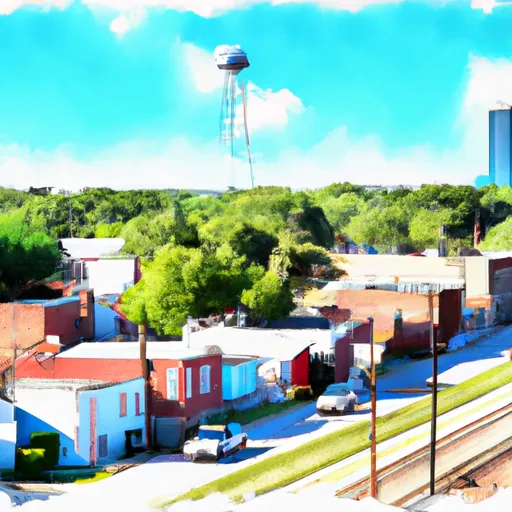-
 Snoflo Premium
Snoflo Premium
Get unlimited access to all our content
With no Ad interruptions! - Start Your Free Trial Login with existing account
Skidmore
Eden Index
Climate
8.9
•
Recreation
3.8
•
Community
2.3
•
Safeguard
5.5/10

Skidmore, Texas is a small rural community located in Bee County. The climate in Skidmore is characterized by hot summers and mild winters. Summers are typically hot and humid, with temperatures frequently exceeding 90°F (32°C), while winters generally remain mild with temperatures averaging around 60°F (15°C). The area receives an average annual rainfall of about 35 inches (89 cm), which sustains the region's diverse hydrology constituents.
Skidmore boasts numerous outdoor recreation opportunities for nature enthusiasts. The region is home to several lakes, rivers, and streams, providing ample opportunities for fishing, boating, and water sports. Outdoor enthusiasts can explore the nearby Choke Canyon State Park, which offers hiking trails, camping sites, and wildlife viewing. The park is particularly known for its birdwatching opportunities, attracting a variety of species throughout the year.
Additionally, Skidmore's surrounding countryside offers picturesque landscapes for hiking, biking, and picnicking. Nature lovers can immerse themselves in the beauty of the area's rolling hills, vibrant wildflowers, and diverse wildlife. Overall, Skidmore provides a serene escape for outdoor enthusiasts seeking to connect with nature and enjoy a variety of recreational activities.
What is the Eden Index?
The Snoflo Eden Index serves as a comprehensive rating system for regions, evaluating their desirability through a holistic assessment of climate health, outdoor recreation opportunities, and natural disaster risk, acknowledging the profound impact of these factors on livability and well-being.
Climate Health Indicator (CHI): 8.9
Skidmore receives approximately
777mm of rain per year,
with humidity levels near 77%
and air temperatures averaging around
22°C.
Skidmore has a plant hardyness factor of
9, meaning
plants and agriculture in this region tend to thrive here all year round.
By considering the ideal temperature range, reliable water supplies, clean air, and stable seasonal rain or snowpacks, the Climate Health Indicator (CHI) underscores the significance of a healthy climate as the foundation for quality living.
A healthy climate is paramount for ensuring a high quality of life and livability in a region, fostering both physical well-being and environmental harmony. This can be characterized by ideal temperatures, reliable access to water supplies, clean air, and consistent seasonal rain or snowpacks.
Weather Forecast
Streamflow Conditions
Central Texas Coastal
Area Rivers
Central Texas Coastal
Snowpack Depths
Central Texas Coastal
Reservoir Storage Capacity
Central Texas Coastal
Groundwater Levels
Recreational Opportunity Index (ROI): 3.8
The Recreational Opportunity Index (ROI) recognizes the value of outdoor recreational options, such as parks, hiking trails, camping sites, and fishing spots, while acknowledging that climate plays a pivotal role in ensuring the comfort and consistency of these experiences.
Access to outdoor recreational opportunities, encompassing activities such as parks, hiking, camping, and fishing, is crucial for overall well-being, and the climate plays a pivotal role in enabling and enhancing these experiences, ensuring that individuals can engage in nature-based activities comfortably and consistently.
Camping Areas
| Campground | Campsites | Reservations | Toilets | Showers | Elevation |
|---|---|---|---|---|---|
| Lake Corpus Christi State Park | 116 | 109 ft | |||
| Nasking Rec Military - Kingsville NAS | None | 49 ft | |||
| Labonte Park | 20 | 7 ft | |||
| John J. Sablatura Park | None | 77 ft | |||
| Palmetto State Park | 40 | 336 ft | |||
| Lake Wood Rec Area | 25 | 298 ft | |||
| Lockhart State Park | 20 | 499 ft | |||
| Kaufer - Hubert - SeaWind RV Park | 134 | 9 ft |
Nearby Fishing
Nearby Ski Areas
Catastrophe Safeguard Index (CSI):
The Catastrophe Safeguard Index (CSI) recognizes that natural disaster risk, encompassing floods, fires, hurricanes, and tornadoes, can drastically affect safety and the overall appeal of an area.
The level of natural disaster risk in a region significantly affects safety and the overall livability, with climate change amplifying these risks by potentially increasing the frequency and intensity of events like floods, fires, hurricanes, and tornadoes, thereby posing substantial challenges to community resilience and well-being.
Community Resilience Indicator (CRI): 2.3
The Community Resilience Indicator (CRI) recognizes that education, healthcare, and socioeconomics are crucial to the well-being of a region. The CRI acknowledges the profound impact of these elements on residents' overall quality of life. By evaluating educational resources, healthcare accessibility, and economic inclusivity, the index captures the essential aspects that contribute to a thriving community, fostering resident satisfaction, equity, and social cohesion.

